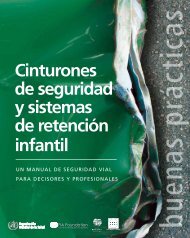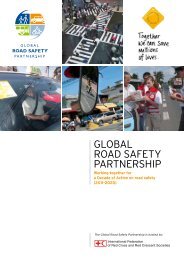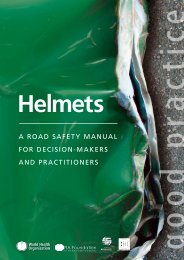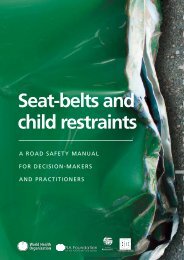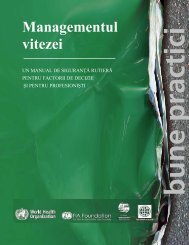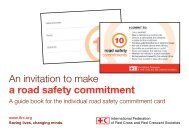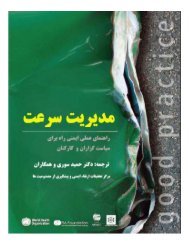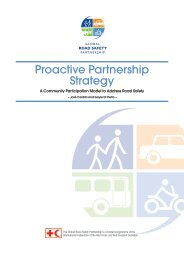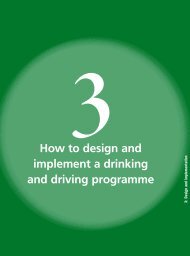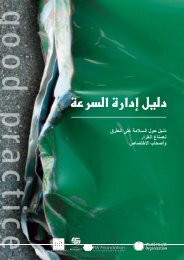How to evaluate the programme - World Health Organization
How to evaluate the programme - World Health Organization
How to evaluate the programme - World Health Organization
Create successful ePaper yourself
Turn your PDF publications into a flip-book with our unique Google optimized e-Paper software.
Helmets: a road safety manual<br />
▷ Are people able <strong>to</strong> circumvent <strong>the</strong> process (for example, using bribery)<br />
Process evaluations are what are known as “formative”. That is, <strong>the</strong> enquiries carried<br />
out are designed <strong>to</strong> provide information <strong>to</strong> guide <strong>programme</strong> improvement (1).<br />
For example, it may be considered important <strong>to</strong> determine whe<strong>the</strong>r <strong>the</strong> TV adverts<br />
shown as part of a helmet <strong>programme</strong> are appropriate – do <strong>the</strong>y adequately address<br />
<strong>the</strong> issue, are <strong>the</strong> helmets advertised actually available for purchase in <strong>the</strong> region<br />
where <strong>the</strong> adverts will be seen<br />
4 | <strong>How</strong> <strong>to</strong> <strong>evaluate</strong> <strong>the</strong> <strong>programme</strong><br />
Impact assessment<br />
This will determine whe<strong>the</strong>r <strong>the</strong> advertisements have brought about a change. The<br />
impact, or <strong>programme</strong> effect, refers <strong>to</strong> a change in <strong>the</strong> target population that has been<br />
brought about by <strong>the</strong> <strong>programme</strong> – that is, a change that would not have occurred<br />
if <strong>the</strong> <strong>programme</strong> had not happened (1). For example, if <strong>the</strong> helmet <strong>programme</strong><br />
involved airing television advertisements on helmet use, <strong>the</strong> impact assessment might<br />
examine whe<strong>the</strong>r people who had seen <strong>the</strong> advertisements believe that <strong>the</strong>re is a good<br />
chance that <strong>the</strong>y will be fined by <strong>the</strong> police if <strong>the</strong>y do not wear a helmet. Unlike a<br />
process evaluation, this would tend <strong>to</strong> take place at <strong>the</strong> end of a <strong>programme</strong>, as <strong>the</strong><br />
focus would be on <strong>the</strong> outcome.<br />
Outcome evaluation<br />
This is where <strong>the</strong> outcomes are measured <strong>to</strong> see if <strong>the</strong> <strong>programme</strong> was successful. Are<br />
more people now wearing helmets than before Have head injuries been reduced<br />
Are more children wearing helmets <strong>to</strong> school Measuring a change in outcomes<br />
is probably <strong>the</strong> most common form of evaluation as it provides information as <strong>to</strong><br />
whe<strong>the</strong>r <strong>the</strong> <strong>programme</strong> or intervention has actually made a difference.<br />
4.2 Choosing <strong>the</strong> evaluation methods<br />
The methods used for each type of evaluation will vary. Both qualitative and<br />
quantitative methods can be used within <strong>the</strong> design of an evaluation. Qualitative<br />
methods may be employed for <strong>the</strong> formative, and process evaluations, e.g. focus<br />
groups, short-answer or open-ended questionnaires.<br />
Impact and outcome evaluations may be carried out using a variety of quantitative<br />
methods. Using an experimental or quasi-experimental design <strong>to</strong> demonstrate a<br />
change (or not) is <strong>the</strong> most powerful <strong>programme</strong> evaluation for detecting changes in<br />
outcome. The type of methods used will depend on <strong>the</strong> aim and <strong>the</strong> budget for <strong>the</strong><br />
evaluation.<br />
127



